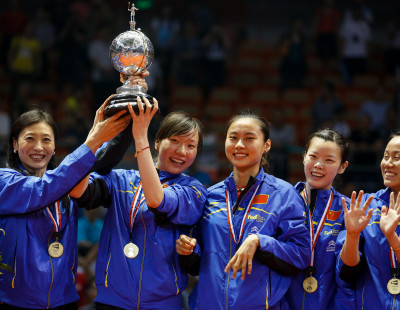If all goes well with the live testing of line-call technology at the BWF World Superseries Finals, there will be widespread implementation of the system next season.
True to its word, the Badminton World Federation is preparing to embrace more innovation, not only with the introduction of instant reviews but also by possibly further optimising its scoring system.
These were among key decisions taken by the BWF Council at its recent meeting in Athens, Greece, following recommendations from the BWF Events Committee, chaired by Peter Tarcala (below; right).
Council members unanimously agreed to integrate line-call technology into badminton from January, provided all technical aspects of the test work according to plan during this week’s BWF World Superseries Finals in Kuala Lumpur, Malaysia. It will be a historic first in badminton as players get the benefit of challenges as happens in various other sports. Line-call technology will make its live debut via a camera-based system, with singles players and doubles pairs on the television (TV) court being permitted to challenge line calls or umpire overrules of line calls. If a line call, after review, is deemed correct the player/pair loses one challenge. Two incorrect challenges means a player/pair will have no more challenges for the duration of the match.
 “This has been a methodical process for us – testing various instant-review technologies. If everything goes well this week, we will be ready to proceed with the next step: large-scale implementation,” said BWF President Poul-Erik Høyer (at left; left).
“This has been a methodical process for us – testing various instant-review technologies. If everything goes well this week, we will be ready to proceed with the next step: large-scale implementation,” said BWF President Poul-Erik Høyer (at left; left).
“However, there are many technical aspects which must be correct. It’s not just about players being able to challenge. We must be able to show replays to officials and ensure everything is operating smoothly.”
Once the live test gets the thumbs-up, players can look forward to using instant reviews more frequently in the Superseries and in Major Events also.
“Players are at the centre of our sport and we have committed to doing everything possible to develop badminton in their best interest,” added Høyer, a former top player.
“This is a vital step which keeps badminton in synch with the trend in many sports today. It is sure to be a hit with fans, both in stadiums and watching on television, as it will add to the on-court intrigue.”
The BWF President also noted that while changes to the scoring system some years ago “improved the game tremendously” it is time to determine if the format can be further optimised to make badminton an “even more exciting spectacle”.
“We will be putting together a framework for test events, using different scoring systems, so we can assess their respective merits,” he said, noting the limited timeframe in which testing can take place given the Olympic qualifying cycle in 2015.
“Some Member Associations, notably China and India, have introduced unique scoring variations in their leagues and we will be seeking feedback from them as well as from the Athletes’ Commission because we want our players to be fully involved in this process. Any decision must have their absolute support as it will affect them first and foremost.”






























